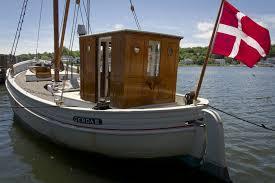Gerda

Gerda. It’s a lovely name, don’t you think. The Gerda III – a lovely name and a lovely boat.
In early December of last year I began work at Mystic Seaport. Mystic, a maritime museum housing a collection of more than 500 watercraft, now that’s a lot of fodder for a wooden boat guy who sits down every other week to pen a post for Write On The Water. Yet, only one of Mystic Seaport’s boats comes to mind as I begin 2015 and that’s Gerda.
There is a lot going on at Mystic Seaport, a place known as The Museum of America and The Sea. There’s the 17 acre museum that provides visitors with experiential learning on land and on the water; the Williams-Mystic undergraduate program with Williams College; a vast collection of ships plans, artwork, photographs and maritime artifacts; the recently rebuilt Charles W. Morgan, the very last of the wooden whalers and our nation’s oldest commercial ship; the 62-foot Sparkman & Stephens Schooner, Brilliant, that sets sail for weeklong voyages. And many amazing vessels from small Adirondack guide boats to tall ships, from yachts to working craft.

And in this museum of American maritime history sits a gray-hulled double-ended powerboat that carries the flag of Denmark. This boat, the Gerda III, is as handsome as could be, lovely in the way that form follows function, her canoe shaped-stern giving her balance in a following sea, her sweeping sheer and rising bow giving her strength with oncoming waves. And Gerda, which was built in 1926 as a lighthouse tender, is no ordinary boat.
The events that define Gerda took place in 1943. Henny Sinding, the 19-year-old daughter of the boat’s manager, along with a four-man crew, used Gerda to save the lives of more than 300 Jewish refugees, hiding them in the ship’s hold, 10 to 15 at a time, setting out on her scheduled route and detouring to the nearby Swedish shore where the refugees could flee Nazi persecution. And during the war, Gerda’s service was also called upon for water rescues of allied airman who were shot down off the coast of Denmark.
Henny and Gerda were not alone in this type of endeavor. In total, more than 7500 Jewish refugees were saved in a similar fashion in 1943, making the trip from Denmark to Sweden. But it is Gerda that lives-on to help us understand this history.
As someone who loves wooden boats, I was first drawn to Gerda for her graceful lines and pleasant shape. Soon, I learned more.
My above words and the accompanying photos could never effectively communicate the feeling experienced when standing alongside this vessel, imagining events from its history. Fortunately, Gerda lives to convey this remarkable story.
By John M. Urban

Share on Facebook



